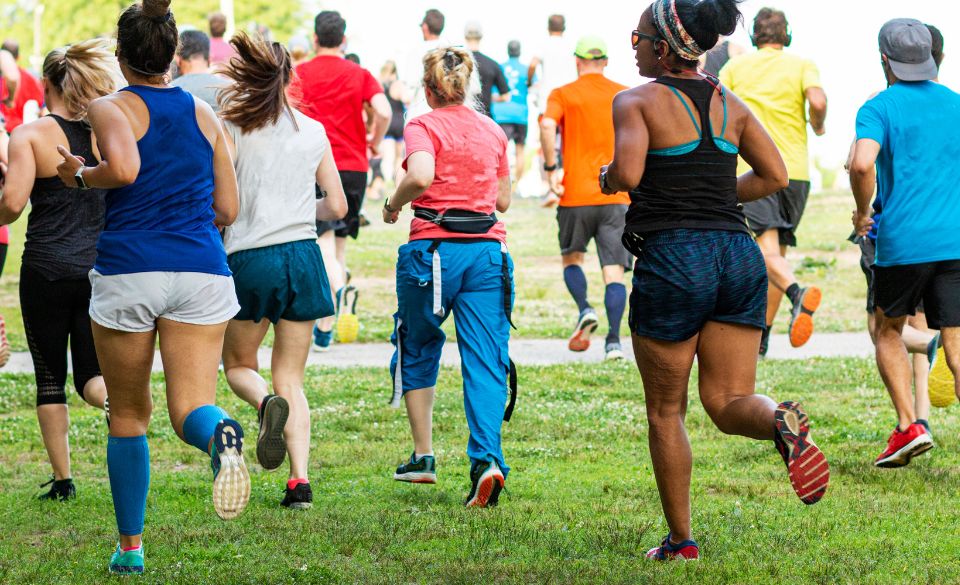
Running on Grass vs. Concrete: Unveiling the Distinct Strides
Page Contents
When it comes to hitting the pavement or feeling the soft embrace of grass beneath your feet, runners often find themselves pondering the age-old question: Is it better to run on grass or concrete? The choice between these surfaces can significantly impact your running experience, performance, and even injury risk. Let’s lace up our running shoes and explore the differences between running on grass and running on concrete.
Running on Grass
Grass is nature’s cushion, offering a gentle and forgiving surface that’s easy on your joints. When you choose to run on grass, you’re trading the unforgiving rigidity of concrete for a surface that absorbs shock and provides a degree of natural cushioning. The softer impact on your feet and knees can be particularly beneficial if you’re recovering from an injury or looking to reduce strain on your joints.
Moreover, grass engages stabilizing muscles that might not be activated as much when running on harder surfaces. This can contribute to better overall muscle balance and enhance your proprioception—the body’s ability to sense its position in space. While grass offers these advantages, it’s important to note that uneven terrain and potential hidden obstacles might require extra attention to your footing.
Running on Concrete
Concrete, the steadfast companion of city runners, provides a consistent and predictable surface. It’s the canvas of urban landscapes, offering flat and firm ground for your strides. Running on concrete offers less give than grass, which means a higher impact on your joints. However, concrete’s predictability can be advantageous for maintaining a steady pace and working on speed training. It’s a surface that mimics the conditions of many races, making it an excellent choice for specific race preparation.
Considerations for Injury Prevention
A study published in the “Journal of Sports Sciences” ventured into the impact forces and loading rates experienced during running on grass versus concrete. The findings indicate that grass, with its cushioning effect, is associated with lower impact forces and loading rates in comparison to concrete. This lower stress on the lower extremity joints, such as ankles, knees, and hips, can potentially contribute to a reduced risk of overuse injuries.
However, the research also underlines the importance of individual adaptation and gradual transition. Runners accustomed to the predictability of concrete might experience a period of adaptation when shifting to grass. Rapid changes in running surface can introduce a different set of challenges and possibly lead to different types of overuse injuries. The key lies in mindful transitioning and understanding your body’s responses to the change in terrain.
Surface Transition and Biomechanics
Another study, featured in the “Journal of Strength and Conditioning Research,” delved into the biomechanical differences between running on grass and running on an asphalt surface. It discovered that running on grass led to lower impact forces and reduced vertical loading rates compared to asphalt. Additionally, grass running was associated with a more flexed knee during ground contact, potentially contributing to the softer impact on joints.
The biomechanical variations extended to ankle and knee joint angles as well. Running on grass induced greater knee flexion and less ankle dorsiflexion at initial contact, suggesting a more adaptive and responsive approach to the softer surface. These biomechanical insights provide a glimpse into the intricate ways our bodies adapt to the running environment, highlighting the need for a balanced and informed approach when transitioning between surfaces.
Strategies for a Balanced Approach
As these studies illuminate the intricate interplay between running surfaces and injury risk, it becomes evident that no single surface is universally superior. A balanced approach, one that incorporates both grass and concrete, emerges as a pragmatic strategy. By blending the advantages of each surface, runners can enhance their training, mitigate injury risks, and adapt effectively to diverse racing conditions.
The Power of Individual Adaptation
The scientific studies underscore the significance of gradual adaptation and individualized training. While grass may offer a gentler landing and reduced impact, the body requires time to adjust to new biomechanical demands. Running on a variety of surfaces, especially during transitions, allows your body to adapt progressively and develop resilience.
Strategies for Variety and Balance
The debate between grass and concrete doesn’t have to be an either-or decision. Incorporating both surfaces into your training regimen can provide a balance between the advantages of each. On softer days, consider indulging in the gentler embrace of grass to minimize impact and activate different muscle groups. On other days, hit the concrete to mimic race conditions and work on maintaining a consistent pace.
The Verdict: Embrace Both Surfaces
As you ponder the age-old debate of grass versus concrete for your running escapades, the resounding verdict might surprise you: Embrace both surfaces. While the allure of one over the other is tempting, the magic lies in striking a harmonious balance between the two. Let’s uncover why integrating both grass and concrete into your running routine can lead to a more well-rounded and fulfilling experience.
The Art of Variety: Why Balance Matters
Variety is the spice of life, and the same holds true for your running regimen. Each surface presents its unique advantages, and by alternating between grass and concrete, you tap into a diverse array of benefits. Running on grass provides a cushioned, joint-friendly experience, while concrete offers a reliable platform for consistency and race simulation. By alternating surfaces, you’re giving your body the opportunity to adapt to various demands and challenges.
The Comfort of Grass: A Natural Respite
Grass running is akin to a soothing retreat for your legs. The plush surface absorbs shock, easing the impact on your joints and muscles. It’s an opportunity to reconnect with nature, trading the concrete jungle for the serenity of verdant trails. When your body craves a gentler touch, grass running steps in as a gentle companion, minimizing the risk of overuse injuries and providing a refreshing change of scenery.
Concrete’s Predictable Partner: The Training Ground
Concrete, on the other hand, acts as your steadfast training partner. Its predictability and firmness make it an ideal canvas for structured workouts, speed training, and maintaining a steady pace. Running on concrete helps you fine-tune your stride, work on consistency, and simulate the conditions of races. It’s a valuable tool in your running toolbox, preparing you for the challenges that organized events might throw your way.
Transitioning with Wisdom: The Path Ahead
While the verdict is to embrace both surfaces, the transition requires mindfulness. If you’re accustomed to the unforgiving nature of concrete, venturing onto grass requires patience and gradual adaptation. Similarly, moving from grass to concrete might necessitate an adjustment period. Remember that your body thrives on consistency but flourishes through calculated variations.




